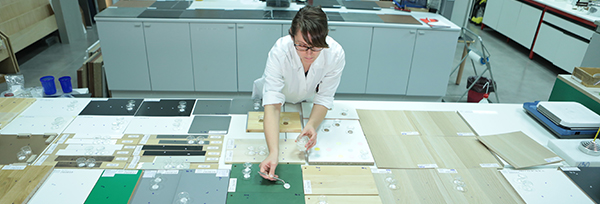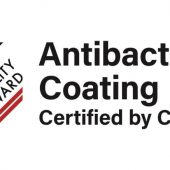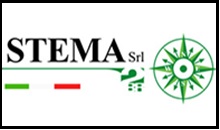The characteristics of surfaces in relation to the “chance of contamination” have never been a burning issue like today. If in the past we looked at the of antibacterial properties of surfaces with great interest, today they could even represent a new global standard, in a world challenged by the Covid-19 pandemic.
An extremely touchy topic, where labels such as “antibacterial” or “antimicrobial” surfaces could represent a fundamental motivation for the market. But what are we really talking about? How the world of furniture can and must deal with materials presenting such new potential?
More and more often the technicians and specialists of Catas, the most important European laboratory for the wood-furniture sector are asked about this topic, and this continuous and growing need of clarifications has convinced them to organize a specific webinar entirely dedicated to this subject.
So, in the Catas Academy calendar there are two important events during which our specialists will talk about antibacterial strategies, sanitizing treatments on different types of surfaces (furniture, appliances and objects of daily use in homes and offices), test methods, interpretation of results and obligations under the relevant legislation, e.g. the European Biocides Regulation.
The two webinars with Elena Conti, a biologist Head of the Microbiological Section of Catas, are scheduled for Thursday 11 June at 2.00 pm (in Italian) and Tuesday 23 June, always at 2.00 pm (in English). Free registration on Catas website www.catas.com; for any further information please contact: formazione@catas.com, phone +39 0432 747260.
A DEEPENING
We take this opportunity to offer you an interesting in-depth analysis by Franco Bulian, the deputy director of Catas, which aim is to clarify and explain the role of surfaces as possible sources of contamination.
FURNITURE SURFACES AT THE TIME OF COVID-19
The term “contagion”, which often occurs in our conversations during this period, has an interesting etymology deriving from the Latin words cum, meaning “together”, and tangere meaning “to touch”.
Indeed, the simple act of touching a surface can be the source of many infections and some studies testify, for example, that the door handles or the elevator buttons of crowded places are among the primary causes of the transmission of many viruses.
These strange “biological entities” are in fact able to easily pass from the surfaces we touch to our hands and from the hands to our mouth and eyes, which represent a kind of open door through which they are finally able enter into our body. In this regard, an Australian study published in 2015 proved that people are used to touch their faces very often (on average 23 times per hour) and viruses take great advantage of such gestures, even unconscious, to considerably spread their diffusion.
The transmission of the virus through the surfaces is evidently based on a first contact deriving from an infected person, mostly through the well-known “droplets” (saliva droplets transmitted through a sneeze, a cough or simply by speaking to another person) followed by the ability of the virus to survive on the contaminated surface.
Recent studies, applied precisely on Covid-19, described a fairly prolonged survival of this virus on plastics (up to 72 hours) and on steel (48 hours), while it is more limited on cardboard or copper.
The most interesting data regarding the interior environments is probably that relating to plastics considering that many of the surfaces around us are coated or in any case covered with laminates or other polymer-based materials that represent the primary constituents of plastics.
Apart from all these theoretical considerations, many practical things have changed in our daily lives as a result of the dramatic effects of Covid-19 and we have learned that besides the mutual distance, the hygiene of our hands and of all the surfaces surrounding us is also crucial.
These new needs and habits are determining significant consequences also for the world of furniture and finishes. There is, in fact, an increasingly requests of antibacterial surfaces and, on the other side, it is considered rather fundamental the ability of furniture surfaces to resist to frequent cleaning and disinfection operations. In this regard, Catas has recently started specific studies collaborating with various partners of our sector.
The antibacterial efficacy of surfaces
The antibacterial effect of furniture surfaces is normally achieved thanks to the addition of particular additives (for example silver base substances) which perform a biocide and/or inhibitory action towards their proliferation. Catas carries out specific tests to study the antibacterial action of plastics and other non-porous materials by contaminating the surfaces under investigation and verifying their effects on bacteria survival. The reference methods are those described by ISO 22196 and JIS Z2801, as well as internal methods specifically created to adapt the test to materials which, due to their intrinsic properties, could not been tested according to the standardized methods.
However, these tests do not consider viruses and in particular Covid-19, which our Institute obviously does not have inside the laboratories …
Resistance to cleaning products and disinfectant liquids
As mentioned above, frequent cleaning and disinfection of surfaces are recommended actions at all levels to counter the spread of Covid-19.
Among the products declaredly effective against the virus, there are alcohol-based preparations and those containing oxidizing agents, such as sodium hypochlorite or hydrogen peroxide.
Alcohol is certainly an agent to be taken into due consideration, as it sometimes tends to cause the softening of some coating films. On the other hand, oxidizing agents may be responsible for discoloration or “fading” even if there are not currently much data available to be able to present a real case study. Finally, particular attention must be paid to the colouring agents that are sometimes added to these cleaning products: if these substances penetrate deeply into the surfaces, they could be difficult to remove, resulting in the formation of coloured areas.
In this regard, Catas has developed a specific investigation protocol (based on EN 12720) to verify the ability of the surfaces to resist contact with cleaning products and commonly used disinfectant liquids.
Resistance to rubbing
In addition to assessment of the sole contact of a liquid with the surface under test, Catas has also developed a test method for assessing the combined effect of contact with rubbing, simulating a real cleaning operation.
The combined effect can in fact be very deleterious, causing various types of damages on furniture surfaces. The tools made available by Catas can undoubtedly represent a valid and ready-to-use aid for the whole market hoping, in any case, that also the standardization world begins to consider and work on these new needs and present challenges.














